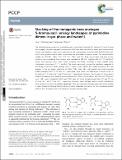Files in this item
Stacking of the mutagenic base analogue 5-bromouracil : energy landscapes of pyrimidine dimers in gas phase and water
Item metadata
| dc.contributor.author | Holroyd, Leo Frederick | |
| dc.contributor.author | van Mourik, Tanja | |
| dc.date.accessioned | 2016-01-05T10:10:05Z | |
| dc.date.available | 2016-01-05T10:10:05Z | |
| dc.date.issued | 2015-12-07 | |
| dc.identifier | 225104503 | |
| dc.identifier | 1b29a12c-505a-4f2e-8d1e-b35bf831cfb3 | |
| dc.identifier | 84946924643 | |
| dc.identifier | 000364862000016 | |
| dc.identifier.citation | Holroyd , L F & van Mourik , T 2015 , ' Stacking of the mutagenic base analogue 5-bromouracil : energy landscapes of pyrimidine dimers in gas phase and water ' , Physical Chemistry Chemical Physics , vol. 17 , no. 45 , pp. 30364-30370 . https://doi.org/10.1039/C5CP04612B | en |
| dc.identifier.issn | 1463-9076 | |
| dc.identifier.other | ORCID: /0000-0001-7683-3293/work/57088465 | |
| dc.identifier.uri | https://hdl.handle.net/10023/7959 | |
| dc.description | The authors gratefully acknowledge EaStCHEM for computer time on the EaStCHEM Research Computing Facility. LFH is grateful to the Engineering and Physical Sciences Research Council for studentship support through the Doctoral Training Account scheme (grant code EP/K503162/1). | en |
| dc.description.abstract | The potential energy surfaces of stacked base pairs consisting of cytosine (C), thymine (T), uracil (U) and the mutagenic thymine analogue 5-bromouracil (BrU) have been searched to obtain all possible minima. Minima and transition states were optimised at the counterpoise-corrected M06-2X/6-31+G(d) level, both in the gas phase and in water, modelled by the polarizable continuum model. The stacked dimers studied are BrU/BrU, C/BrU, C/C, C/T, C/U, T/BrU and T/U. Both face-to-back and face-to-face structures were considered. Free energies were calculated at 298.15 K. Together with U/U, T/T and BrU/U results from previous work, these results complete the family consisting of every stacked dimer combination consisting of C, T, U and BrU. The results were used to assess the hypothesis suggested in the literature that BrU stacks stronger than T, which could stabilise the mispair formed by BrU and guanine. In the gas phase, structures of C/BrU, T/BrU and U/BrU with greater zero-point-corrected binding energies than C/T, T/T and U/T, respectively, were found, with differences in favour of BrU of 3.1 kcal mol−1, 1.7 kcal mol−1 and 0.5 kcal mol−1, respectively. However, the structure of these dimers differed considerably from anything encountered in DNA. When only the dimers with the most “DNA-like” twist (±36°) were considered, C/BrU and T/BrU were still more strongly bound than C/T and T/T, by 0.5 kcal mol−1 and 1.7 kcal mol−1, respectively. However, when enthalpic and/or solvent contributions were taken into account, the stacking advantage of BrU was reversed in the gas phase and mostly nullified in water. Enhanced stacking therefore does not seem a plausible mechanism for the considerably greater ability of BrU–G mispairs over T–G mispairs to escape enzymatic repair. | |
| dc.format.extent | 1636929 | |
| dc.language.iso | eng | |
| dc.relation.ispartof | Physical Chemistry Chemical Physics | en |
| dc.subject | QD Chemistry | en |
| dc.subject | DAS | en |
| dc.subject.lcc | QD | en |
| dc.title | Stacking of the mutagenic base analogue 5-bromouracil : energy landscapes of pyrimidine dimers in gas phase and water | en |
| dc.type | Journal article | en |
| dc.contributor.institution | University of St Andrews. School of Chemistry | en |
| dc.contributor.institution | University of St Andrews. EaSTCHEM | en |
| dc.identifier.doi | 10.1039/C5CP04612B | |
| dc.description.status | Peer reviewed | en |
| dc.identifier.url | http://www.rsc.org/suppdata/c5/cp/c5cp04612b/c5cp04612b1.pdf | en |
This item appears in the following Collection(s)
Items in the St Andrews Research Repository are protected by copyright, with all rights reserved, unless otherwise indicated.

